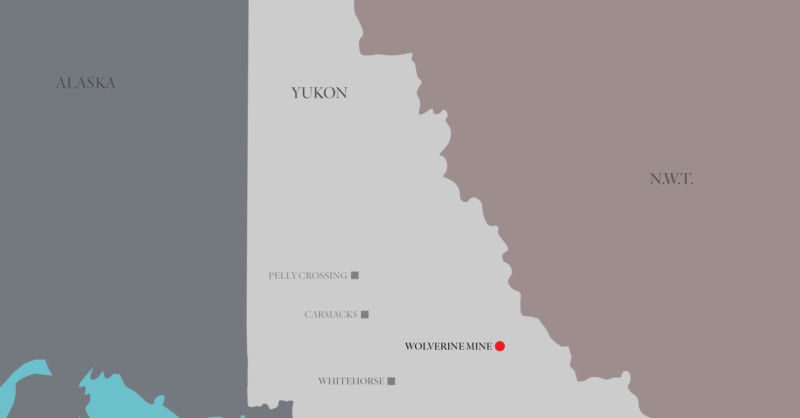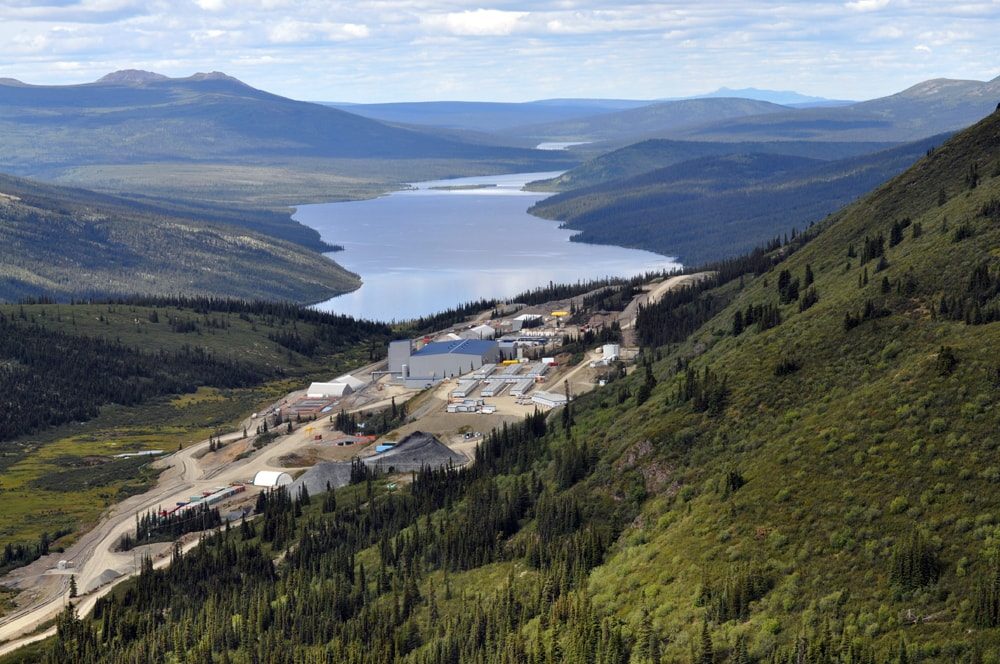
Rocky Mountain coal mine in Alberta takes next step to expansion
In Alberta, a massive open-pit coal mine near Jasper National Park is hoping to expand...
Yukon’s Wolverine mine, which primarily extracted zinc before it closed in 2015, has a storied history of failure.
It opened and closed with only a few years of production, due to plummeting stocks. It left a flooded underground shaft and contaminated water in its wake. And in 2018, the Yukon government was forced to step in to start environmental monitoring as the mine site had been neglected by Yukon Zinc, owned by the private Chinese company Jinduicheng Canada Resources Corp.
Now the bill is growing every year to keep the Wolverine mine from polluting the landscape around it, the territory’s mine closure fund is drying up and its bankrupt owner has walked away — in a situation one mining analyst says reveals flaws in Yukon’s bonding system for mines.
Lewis Rifkind, the mining analyst at the Yukon Conservation Society, says the case of Wolverine mine reveals how nearsighted the current security regime is, leaving territorial taxpayers on the hook for cleanup costs down the road.
A recent Yukon Supreme Court decision confirms the Yukon government will be the first recipient of dollars flowing from bankruptcy proceedings for Yukon Zinc, the company that built Wolverine mine in southeast Yukon. On May 26, a judge ruled that once the government spends the roughly $10.6 million in bonding already held to clean up the Wolverine mine site, any money acquired through the liquidation of assets, for instance, will go toward its continued remediation work.
This is the first instance of the territorial government taking a mining company to court for defaulting on its claim. The territory only took over management of resources and remediation from the federal government in 2003, at which point its regime for collecting securities was written.
What this first court case doesn’t do is affect that underlying system, Rifkind says, adding that how much a mining company must pay in a security deposit upfront is “opaque.”
“It would appear that it always comes up short when it comes to security,” Rifkind says. “The Wolverine mine is the prime example.”
Before a mine goes into operation, a required security deposit is decided on between the Yukon government and the mining company. That figure represents the estimated cost of cleaning up the mine after it’s no longer operational.
The amount is calculated for mines on a case by case basis, depending on the degree of land the project will disturb, a departmental spokesperson from Yukon’s Department of Energy, Mines and Resources told The Narwhal, adding that ongoing reclamation work throughout the life of the mine can keep security costs down.
The miner has to pay 100 per cent of its security deposit to the Yukon government before it can go into operation. The territorial government reviews that amount every two years and it could increase if, for example, additional infrastructure is built on the mine site.

Location of the Wolverine mine in Yukon. Map: Carol Linnitt / The Narwhal
In the case of Yukon Zinc, the company paid an initial security deposit of $1.78 million when it received its mining licence in 2006. Commercial production began in 2012 and by 2013 the security increased to $10.6 million.
A study conducted by PricewaterhouseCoopers Inc. last summer, which delved into the strengths and shortcomings of the Yukon government’s security regime system, found the requirement for security to be paid upfront doesn’t necessarily alleviate the financial risks associated with a mine in the long-term.
“The estimated costs for reclamation and closure evolve over the life of the mine, which is why updates to the (quartz mining licence) are required at least every two years. In the case of the Wolverine mine, the company allowed liabilities to increase at the site, a decision that was influenced by their financial difficulties and lack of accountability to shareholders,” it stated.
Considering the unforeseen environmental damage at the site, the government requested an extra $25 million in securities from Yukon Zinc in 2018, arguing the full cost of remediation would now be more than $35 million. This amount was never paid.
In July 2019, the Yukon government petitioned to have Yukon Zinc put into receivership so its assets could be liquidated and those funds put back into cleaning up the mess left by the delinquent miner. That request was granted by the Supreme Court of Yukon on Sept.13, with PricewaterhouseCoopers taking control of proceedings and the mine. Yukon Zinc declared bankruptcy in October 2019.
In its recent ruling, the Yukon Supreme Court waived the territorial government’s request for an additional $25 million — now coming from Yukon Zinc’s bankruptcy proceedings — arguing it wasn’t clear whether that exact amount would be required for the mine clean up. The judge also urged the government to be more proactive in the future, noting such a significant increase to the security over the course of 2018, when the company was already in “financial difficulties,” was not reasonable.
This is also a tough amount to raise for remediation work now that the mine is closed and unlikely to find a buyer.
“The concern is how do you get $35 million out of that site?” Rifkind says. “It’s a bit of a contaminated mess.”
Care and maintenance costs could still increase at the Wolverine mine site, which is something that needs to be watched closely, Rifkind says, as the government quickly eats away at the security in place.
Last month, the Yukon Supreme Court approved PricewaterhouseCoopers’s request to increase the sum borrowed from the Yukon government to cover the inflating care and maintenance costs at the mine from $3 million to $7.5 million. A government spokesperson confirmed that money would be borrowed from the territorial government but it is unclear where exactly those funds are coming from or whether they’ll be paid back through bankruptcy proceedings.
A spokesperson with Energy, Mines and Resources confirmed that money for treating water at the site is accounting for a “significant portion of the care and maintenance costs.”
When Wolverine’s underground mine flooded in 2017, the resulting contaminated water had to be diverted to the mine’s tailings pond, treated and then discharged. Yukon Zinc was supposed to build a water treatment plant by 2015 as per its licence, issued two years prior. That never happened, so the government was left to build it.

Wolverine mine, between Ross River and Watson Lake, Yukon on Kaska territory. Photo: Yukon government
“The cost of the water treatment plant accounted for approximately 60 per cent of the increase in security that the company has not paid,” says a Yukon government report, noting the government-run plant started discharging treated water last September.
The Yukon government has already directed $5.8 million of the $10.6 million from Yukon Zinc’s security to pay for the cost of work to treat and discharge 15,000 cubic metres of water from the facility, a department of mines spokesperson told The Narwhal earlier this year.
“There are technical issues on-site that can be resolved, but it takes money,” Rifkind says. “The question is: is there enough money, and, if there isn’t, where does the money come from?”
And the longer it takes for remediation work to be completed, the higher the likelihood that security is chewed up by ongoing care and maintenance costs, such as dealing with contaminated water, Rifkind says.
He adds it shouldn’t take a court decision for taxpayers to be privy to the fact that mine care and maintenance costs are climbing, and these costs could land on them.
With other mine projects on their way through the assessment process — Coffee Gold, for instance, which, by its current estimated production value, could be the largest gold mine Yukon has ever seen — the government needs to ensure that security costs don’t get out of control, Rifkind says. Otherwise, Yukon could be facing the same situation — only perhaps costlier — a decade from now.
“Something needs to be done now to ensure there’s increased money for closure,” he says.
That work has started. The report by PricewaterhouseCoopers recommended the Yukon government conduct a more robust risk assessment prior to handing out licences. This could include studying a company’s financial assessments, the plan for the lifecycle of the mine and changing market forces. Based on these factors, the report said the government could enforce bonding that’s higher than 100 per cent of the security estimate.
The Yukon government shot down this idea in a subsequent report, arguing it had strengthened the system in 2013 with the provision to increase required security based on additional infrastructure added to the mine site. It called on PricewaterhouseCoopers to review the feasibility of establishing a territory-wide reclamation fund to manage unpaid clean-up fees.
A second report is expected this year but an Energy, Mines and Resources spokesperson said it hasn’t yet been finalized. It’s unclear at this time who would pay into the fund — whether it would be Yukon taxpayers, the federal government or companies themselves.
To Rifkind, this suggests solutions are few and far between.
“I think we’re going to get more and more Wolverine mines if we keep doing this the way we’re doing it,” he says. “We’ve learned nothing.”
Get the inside scoop on The Narwhal’s environment and climate reporting by signing up for our free newsletter. A $335 million funding commitment to fund...
Continue reading
In Alberta, a massive open-pit coal mine near Jasper National Park is hoping to expand...

A trade war could help remake B.C.’s food system, but will family farmers be left...

First Nations are leading efforts to make sure lake sturgeon can find a home in...
